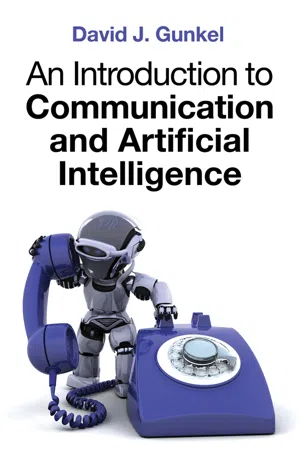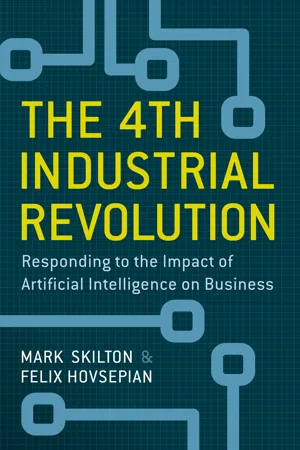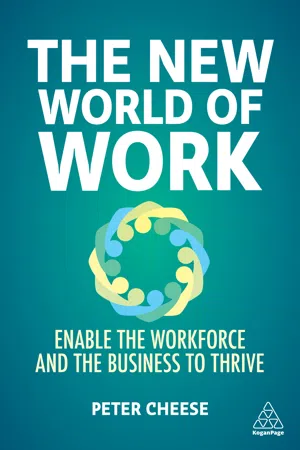Computer Science
Impact of AI and Automation
The impact of AI and automation in computer science encompasses the transformation of various industries through the use of intelligent machines and algorithms to perform tasks traditionally carried out by humans. This includes increased efficiency, productivity, and the potential for job displacement. Additionally, it raises ethical and societal considerations regarding the future of work and the need for retraining and upskilling.
Written by Perlego with AI-assistance
Related key terms
5 Key excerpts on "Impact of AI and Automation"
- David J. Gunkel(Author)
- 2020(Publication Date)
- Polity(Publisher)
Part IIIImpact and ConsequencesPassage contains an image
8 Social Issues
Key Aims/Objectives
- To introduce and critically investigate the concepts, historical trajectory, and current situation regarding automation and technological unemployment.
- To identify the challenges to existing educational concepts, structures, and methodologies introduced by workplace automation, and to consider both “updates” and “mods” that can be implemented to respond to these challenges.
- To “future proof” education and student careers in order to be prepared to meet the demands of the twenty-first century.
Introduction
As we have seen in our investigations, we are in the midst of something like a robot invasion. Intelligent (or at least, semi-intelligent, or what can also be called “smart”) machines are everywhere and doing virtually everything. We chat with them both on- and offline, we interact with them at work and at play, and we rely on their seemingly inexhaustible and ever improving capabilities to manage many aspects of our increasingly complex data-driven lives. This “invasion” is not something that takes place as we have imagined it in decades of science fiction literature and film. It does not happen by way of a marauding army of evil-minded androids descending from the heavens with ray-guns of immeasurable power. It is an already occurring event with intelligent and autonomous technology of various configurations and capabilities coming to take up positions in our world through a slow but steady incursion. It looks less like Terminator and Battlestar Galactica- Mathew Donald(Author)
- 2019(Publication Date)
- Emerald Publishing Limited(Publisher)
Chapter 3
Organisational Implications of Artificial Intelligence
AI does not mean no humans; it will just change the way things work. —Mathew DonaldArtificial intelligence (AI) may be transformational (Boyd & Holton, 2018), where the concept of automation and AI have been discussed in the literature since as early as the 1970s (Felsen, 1975). The amount of data available in repositories may have exceeded the human capability to process (Crombez & Dahms, 2015), where AI may now even be an essential element to operate them. Science fiction has imagined for over 50 years that AI may emerge to rival the human race (Benson, 2018); yet to date, that has not occurred. A more robust definition for the term AI may be required in the future should quality, ethics or other legal matters present as AI develops (Lehman-Wilzig, 1981). AI may also have elements of games, mimicking human thought and products for use by humans (Parnas, 2017). As AI emerges, there will be new product opportunities, whilst there is a societal risk of dislocation and widespread unemployment in its wake (Makridakis, 2017), where new skills may be required (Engelbrecht, 2017).Smartphones today have vast computing power, connectivity to Internet and social media, with many including location and the global positioning systems (GPS) and other advanced technologies. These new technologies impact on individual and organisational communication, information and transactions amongst many others. Many new cars are already fitted with computers that control engines, many with smartphones or GPS capabilities and thus driving is already vastly different to that in 1980. As was discussed in Chapter 2- eBook - ePub
The 4th Industrial Revolution
Responding to the Impact of Artificial Intelligence on Business
- Mark Skilton, Felix Hovsepian(Authors)
- 2017(Publication Date)
- Palgrave Macmillan(Publisher)
© The Author(s) 2018Begin AbstractThe 4th Industrial Revolution https://doi.org/10.1007/978-3-319-62479-2_11Mark Skilton andFelix Hovsepian11. Example Case Studies of Impact of Artificial Intelligence on Jobs and Productivity
End AbstractMark Skilton1andFelix Hovsepian2(1) Knowle, Solihull, UK(2) Meriden, UKIntroduction
“If there is a chance to improve and upscale the quality and efficiency of systems and operations, why wouldn’t everyone take the opportunity?” was raised by a Nikhil Kulkami, a recent graduate. He is very much the next generation that will have much to say in how the workplace and society will change. This is the scope of where we are planning to head, especially with the drive to implement more intelligent solutions for the infrastructures available in today’s society; this drive is being achieved through integrating artificial intelligence (AI), which is the goal of allowing ‘computer systems to exhibit intelligence in some manner’ [1 ]. Artificial intelligence has progressed from the development standpoint in computer science to being fully used to extract, analyse and predict vast amounts of data in varying industries. The integration of technologies like AI is helping improve the operation and efficiency of several infrastructures, as well as reducing their financial costs.The next section in this document highlights real examples of industries which have implemented artificial intelligence in their daily processes. We provide a summary table for quick reference of the types of Artificial Intelligence and the pragmatic impact of these in managing planned and unplanned outcomes. We then provide a list of practitioner case studies that describe how artificial intelligence is being used today. - eBook - ePub
Artificial Intelligence in Higher Education
A Practical Approach
- Prathamesh Padmakar Churi, Shubham Joshi, Mohamed Elhoseny, Amina Omrane, Prathamesh Padmakar Churi, Shubham Joshi, Mohamed Elhoseny, Amina Omrane(Authors)
- 2022(Publication Date)
- CRC Press(Publisher)
People want an easy life and AI is making it so, such as in helping humans to multitask where it was not possible before. For instance, people can now turn on their home air conditioning systems while driving before reaching home, and they can view the person at their doorbell via a camera while doing their work in their bedrooms. AI is now revolutionizing companies to compete and grow across the world by presenting new production factors that drive business towards record profits. Realizing the importance of AI, business sectors are grabbing up opportunities and developing active AI strategies. Although businesspeople are primarily concerned with whether their products have a market, they also consider their development with moral and ethical questions in mind, which resultantly leads to positive feedback, empowering people with superior innovations.AI is not just helping us to improve our lives but in some cases it is helping us to save our lives, as AI serves the healthcare systems by providing powerful diagnostic tools for health. With the help of AI, many robots have been invented to assist in different surgeries. AI also addresses today’s contemporary challenges and issues, such as global warming. Invention of smart infrastructures, smart appliances and smart agricultural techniques are helping more efficiently with natural resources. AI also provides benefits in fields like engineering, economics, linguistics, law, manufacturing and many more.11.7 How Artificial Intelligence (AI) will Influence the World in THE Future
AI seems a hot topic to discuss nowadays because of its ubiquity and impact in every field of life, and this discussion leads to the prevalence of AI in the future. It is changing the world with each single day with new autonomous inventions. AI and Robotics can impact people’s lives both negatively as well as positively, especially regarding careers and jobs. Moreover, world-renowned personalities like Stephen Hawking and Bill Gates have predicted mass unemployment due to the rise of Smart Technology, AI, Robotics and algorithms—termed as STARA (Bort, 2014 ). It was estimated that approximately one-third of the present jobs can be replaced by STARA by 2025 (Frey & Osborne, 2013 - eBook - ePub
The New World of Work
Shaping a Future that Helps People, Organizations and Our Societies to Thrive
- Peter Cheese(Author)
- 2021(Publication Date)
- Kogan Page(Publisher)
The fourth industrial revolution, also referred to as Industry 4.0, has the potential to be as era defining as the first industrial revolution. It will impact us all. Technology has therefore been the focus of so much of the debate in recent years about the future of work. But as we have already seen, it is coming together with other significant shifts and changes. Taken together they add up to perhaps a perfect storm, but certainly to a new era.A new era driven by data and artificial intelligence
Data is the new fuel of Industry 4.0. And artificial intelligence in its many manifestations is the engine that uses that fuel to drive the new era.Artificial intelligence underpins almost all the new fields of technology. The basic definition of AI is technology that seeks to automate or simulate what we would generally describe as intelligent behaviour. AI in its basic forms has been with us since the 1950s but is now a huge field with many different levels of sophistication and application, enabled by huge advances in data-processing power and capabilities.To better understand AI and its pervasive range of applications, there are some generally accepted classifications6 which are based on relating AI to human-type intelligence:-
The most basic AI are ‘reactive machines’, which automatically respond to limited sets of inputs but have no memory. This level of AI has been with us for decades and widely applied. Just think of heating sensors or speed cameras.
-
The next level are ‘limited memory machines’, which can learn from historical data to make ‘decisions’ or alter outputs. This level of AI therefore includes machine learning whereby AI systems repeat tasks and refine their predictive outputs, for example in marketing analytics or chatbots. Within machine learning is so-called deep learning where applications are increasingly able to train themselves to perform tasks without further input – voice- and image-recognition applications would be examples.
These first two levels are broadly where we are today. AI at these levels is limited to specific tasks based on predetermined and predefined ranges. This is also called artificial narrow intelligence (ANI) or narrow AI. However, it is already clear that many higher-order analytical and cognitive tasks can be performed even better than humans can perform them, allowing automation to move beyond basic administrative or routine tasks. Driverless vehicles are a fascinating example – while they may look like they have a wider intelligence, they are operating from huge combinations of very specialized ANI applications.
Learn about this page
Index pages curate the most relevant extracts from our library of academic textbooks. They’ve been created using an in-house natural language model (NLM), each adding context and meaning to key research topics.




